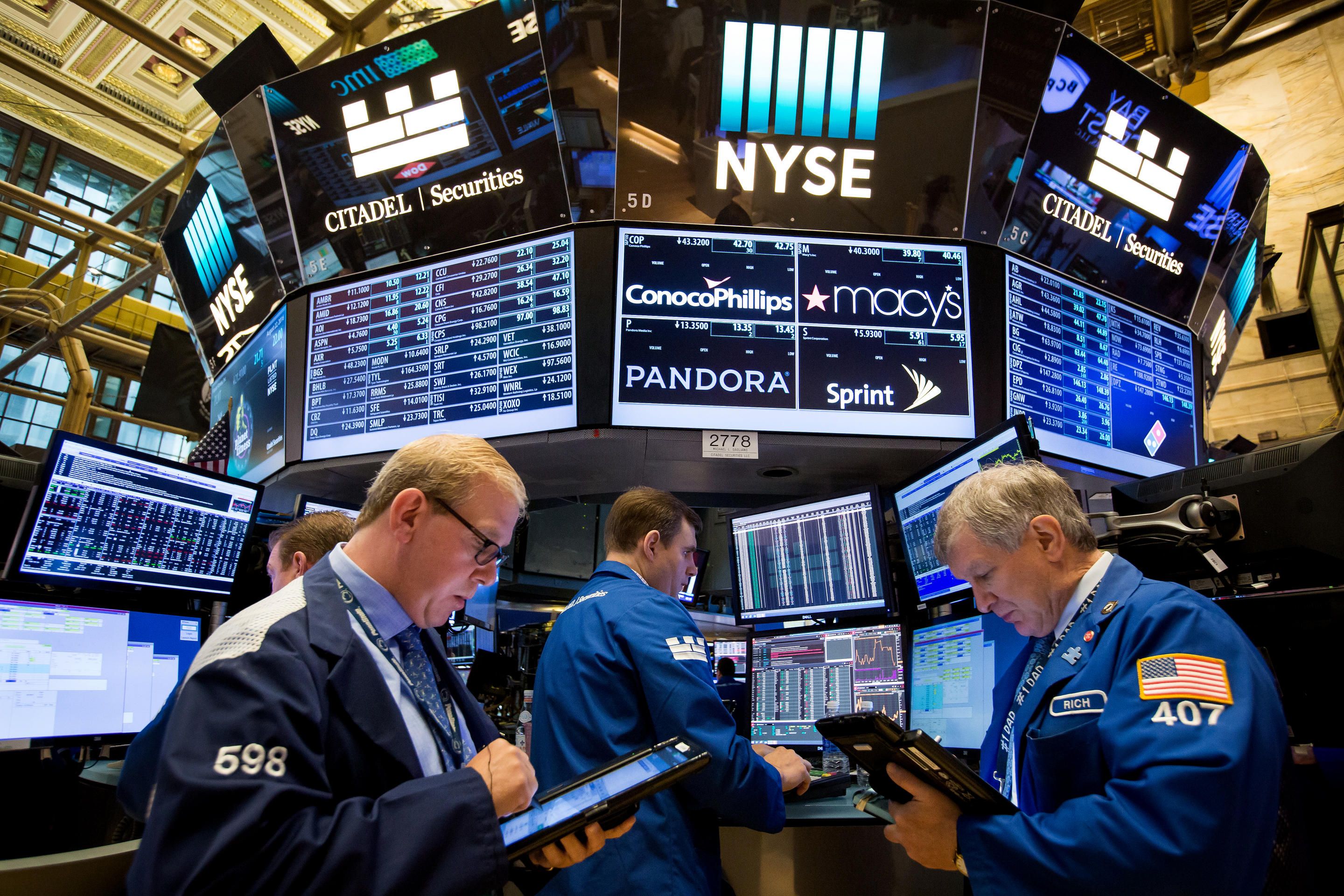Economy
Trade Concerns May Continue to Weigh on US Stocks

By Investors Hub
The major U.S. index futures are pointing to a lower opening on Thursday, with stocks likely to extend the pullback seen over the course of the previous session.
The downward momentum on Wall Street may partly reflect concerns about the global economic impact on the ongoing trade dispute between the U.S. and other major economies.
Negative sentiment may also be generated in reaction to a Commerce Department report showing weaker than previously estimated U.S. economic growth in the first quarter.
After failing to sustain an early move to the upside, stocks turned lower over the course of the trading session on Wednesday. The major averages all pulled back off their best levels of the day and into negative territory.
The major averages ended the session just off their worst levels of the day. The Dow fell 165.52 points or 0.7 percent to 24,117.59, the Nasdaq plunged 116.54 points or 1.5 percent to 7,445.08 and the S&P 500 slid 23.43 points or 0.9 percent to 2,699.63.
Stocks initially benefited from news that President Donald Trump’s plan to crack down on Chinese investments in the U.S. is less harsh than feared.
Administration officials told reporters Trump wants to strengthen the Committee on Foreign Investment in the U.S. to prevent foreign companies from violating intellectual-property rights of American companies.
Trump expressed support for legislation that would expand CFIUS’ authority in a White House statement released Wednesday.
The president said the bill known as the Foreign Investment Risk Review Modernization Act would enhance the administration’s ability to protect the U.S. from new and evolving threats posed by foreign investment.
Trump argued the legislation would still sustain the strong, open investment environment to which the country is committed and which benefits the U.S. economy.
Reports earlier this week suggested Trump intended to use the International Emergency Economic Powers Act of 1977 to limit Chinese investment in the U.S.
However, technology stocks came under pressure over the course of the session, contributing to the steep drop by the Nasdaq.
In U.S. economic news, the Commerce Department released a report showing a smaller than expected decrease in new orders for U.S. manufactured durable goods in the month of May.
The Commerce Department said durable goods orders fell by 0.6 percent in May after tumbling by a revised 1.0 percent in April.
Economists had expected durable goods orders to drop by 1.0 percent compared to the 1.6 percent slump that had been reported for the previous month.
Excluding orders for transportation equipment, durable goods orders dipped by 0.3 percent in May after spiking by 1.9 percent in April. Ex-transportation orders had been expected to rise by 0.5 percent.
Meanwhile, a separate report from the National Association of Realtors showed an unexpected decrease in pending home sales in May.
NAR said its pending home sales index fell by 0.5 percent to 105.9 in May after slumping by 1.3 percent to 106.4 in April. Economists had expected pending home sales to climb by 0.5 percent.
Biotechnology stocks moved sharply lower over the course of the trading session, dragging the NYSE Arca Biotechnology Index down by 2.8 percent. With the drop, the index fell to its lowest closing level in over a month.
Substantial weakness also emerged among semiconductor stocks, as reflected by the 2.5 percent loss posted by the Philadelphia Semiconductor Index. The index also slid to its worst closing level in well over a month.
Financial, steel, gold and computer hardware stocks also came under pressure over the course of the session, contributing to the pullback by the broader markets.
On the other hand, significant strength remained visible among energy stocks, which moved higher along with the price of crude oil.
Reflecting the strength in the energy sector, the Philadelphia Oil Service Index surged up by 2.9 percent, while the NYSE Arca Natural Gas Index and the NYSE Arca Oil Index both climbed by 1.1 percent.
Economy
NBA Demands Suspension of Controversial Tax Laws

By Modupe Gbadeyanka
The federal government has been asked by the Nigerian Bar Association (NBA) to suspend the implementation of the controversial tax laws.
In a reaction to the tax reform acts, the president of the group, Mr Afam Osigwe (SAN), the suspension of the laws would allow for a proper investigation into allegations of alterations in the gazetted and harmonised copies.
A member of the House of Representatives, Mr Abdussamad Dasuki, alleged that some parts of the laws passed by the parliament were different from the gazetted copy.
To address the issues raised, the NBA said it is “imperative that a comprehensive, open, and transparent investigation be conducted to clarify the circumstances surrounding the enactment of the laws and to restore public confidence in the legislative process.”
“Until these issues are fully examined and resolved, all plans for the implementation of the Tax Reform Acts should be immediately suspended,” the association declared.
It noted that the controversies “raise grave concerns about the integrity, transparency, and credibility of Nigeria’s legislative process.”
“These developments strike at the very heart of constitutional governance and call into question the procedural sanctity that must attend lawmaking in a democratic society,” it noted.
“Legal and policy uncertainty of this magnitude has far-reaching consequences. It unsettles the business environment, erodes investor confidence, and creates unpredictability for individuals, businesses, and institutions required to comply with the law. Such uncertainty is inimical to economic stability and should have no place in a system governed by the rule of law.
“Nigeria’s constitutional democracy demands that laws, especially those with profound economic and social implications, emerge from processes that are transparent, accountable, and beyond reproach. Anything short of this undermines public trust and weakens the foundation upon which lawful governance rests.
“We therefore call on all relevant authorities to act swiftly and responsibly in addressing this controversy, in the overriding interest of constitutional order, economic stability, and the preservation of the rule of law,” the organisation stated.
Economy
MRS Oil, Two Others Raise NASD Bourse Higher by 0.52%

By Adedapo Adesanya
Demand for hot stocks, including MRS Oil Plc, buoyed the NASD Over-the-Counter (OTC) Securities Exchange by 0.52 per cent on Tuesday, December 23.
The energy company was one of the three price gainers for the session as it chalked up N19.69 to sell at N216.59 per share versus the previous day’s value of N196.90 per share.
Further, FrieslandCampina Wamco Nigeria Plc gained N2.95 to close at N56.75 per unit versus N53.80 per unit and Golden Capital Plc appreciated by 84 Kobo to N9.29 per share from Monday’s N8.45 per share.
Consequently, the market capitalisation went up by N10.95 billion to N2.125 trillion from N2.125 trillion and the NASD Unlisted Security Index (NSI) rose by 18.31 points to 3,570.37 points from 3,552.06 points.
Yesterday, the NASD bourse recorded a price loser, the Central Securities Clearing System Plc (CSCS), which gave up 17 Kobo to close at N33.70 per unit against the previous trading value of N33.87 per unit.
The volume of securities traded at the session went down by 97.6 per cent to 297,902 units from the previous day’s 12.6 million units, the value of securities decreased by 98.5 per cent to N10.5 million from N713.6 million, and the number of deals remained flat at 32 deals.
By value, Infrastructure Credit Guarantee Company (InfraCredit) Plc ended as the most actively traded stock on a year-to-date basis with 5.8 billion units exchanged for N16.4 billion. This was followed by Okitipupa Plc, which traded 178.9 million units valued at N9.5 billion, and MRS Oil Plc with 36.1 million units worth N4.9 billion.
In terms of volume, also on a year-to-date basis, InfraCredit Plc led the chart with a turnover of 5.8 billion units traded for N16.4 billion. Industrial and General Insurance (IGI) Plc ranked second with 1.2 billion units sold for N420.7 million, while Impresit Bakolori Plc followed with the sale of 536.9 million units valued at N524.9 million.
Economy
NGX All-Share Index Soars to 153,354.13 points

By Dipo Olowookere
It was another bullish trading session for the Nigerian Exchange (NGX) Limited as it closed higher by 0.59 per cent on Tuesday.
The market further rallied due to continued interest in large and mid-cap stocks on the exchange by investors rebalancing their portfolios for the year-end.
Yesterday, Aluminium Extrusion sustained its upward trajectory after it further appreciated by 9.96 per cent to N14.90, as Austin Laz gained 9.81 per cent to close at N2.91, Custodian Investment improved by 9.69 per cent to N38.50, and First Holdco soared by 9.35 per cent to N50.30.
Conversely, Royal Exchange declined by 7.22 per cent to N1.80, Champion Breweries shrank by 6.57 per cent to N15.65, NASCON lost 5.36 per cent to trade at N105.05, Sovereign Trust Insurance depreciated by 5.28 per cent to N3.77, and Japaul went down by 4.51 per cent to N2.33.
At the close of business, 29 shares ended on the gainers’ table and 27 shares finished on the losers’ log, representing a positive market breadth index and bullish investor sentiment.
This raised the All-Share Index (ASI) by 895.06 points to 153,354.13 points from 152,459.07 points and lifted the market capitalisation by N579 billion to N97.772 trillion from the previous day’s N97.193 trillion.
VFD Group finished the day as the busiest stock after it recorded a turnover of 192.0 million units worth N2.1 billion, GTCO exchanged 63.5 million units valued at N5.6 billion, Access Holdings traded 49.8 million units for N1.0 billion, First Holdco sold 45.8 million units valued at N2.3 billion, and Secure Electronic Technology transacted 38.3 million units worth N28.4 million.
In all, market participants bought and sold 677.4 million units valued at N20.8 billion in 27,589 deals compared with the 451.5 million units worth N13.0 billion traded in 33,327 deals on Monday, showing an improvement in the trading volume and value by 50.03 per cent and 60.00 per cent apiece, and a shortfall in the number of deals by 17.22 per cent.
-

 Feature/OPED6 years ago
Feature/OPED6 years agoDavos was Different this year
-
Travel/Tourism9 years ago
Lagos Seals Western Lodge Hotel In Ikorodu
-

 Showbiz3 years ago
Showbiz3 years agoEstranged Lover Releases Videos of Empress Njamah Bathing
-

 Banking8 years ago
Banking8 years agoSort Codes of GTBank Branches in Nigeria
-

 Economy3 years ago
Economy3 years agoSubsidy Removal: CNG at N130 Per Litre Cheaper Than Petrol—IPMAN
-

 Banking3 years ago
Banking3 years agoFirst Bank Announces Planned Downtime
-

 Banking3 years ago
Banking3 years agoSort Codes of UBA Branches in Nigeria
-

 Sports3 years ago
Sports3 years agoHighest Paid Nigerian Footballer – How Much Do Nigerian Footballers Earn













